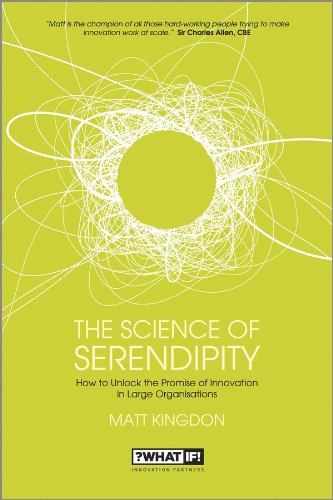Why this book from 2012 matters
Matt Kingdon, drawing on decades of experience working with large organizations and driving innovation, presents serendipity not as mere luck but as something that can be systematically encouraged. The subtitle, How to Unlock the Promise of Innovation, hints at his goal: to provide a playbook for how “lucky” breakthroughs often have underlying patterns.
Especially in large companies (often slower, rigid, full of red-tape), Kingdon argues that innovation isn’t the exclusive domain of scrappy start-ups; these big firms face unique challenges and deserve serious attention.
How the book treats serendipity
Here are some of the key ways this book handles or frames the idea of serendipity:
Serendipity as “making your own luck”
Kingdon repeatedly emphasizes that many “fortunate” moments in innovation come from deliberate intention, not passive waiting. The quote at the start about “good innovators make their own luck” captures that nicely.
Structured approach: Protagonist, Provocation, Collision, Realisation, Organisation
The book is organized into chapters such as The Protagonist, The Quest for Provocation, Making Ideas Real, Collision Course, and Battling the Corporate Machine. These provide a logical sequence: from mindset → stimulus → environment → realization → organizational challenges.
Physical and social environments matter
Kingdon argues that serendipity thrives where people from different backgrounds collide, share ideas, and rapid experimentation is encouraged. Example: a deliberately “messy” workspace or common area that forces informal collisions.
The human dimension: mindset, perseverance, agility
Serendipity is not just about “chance.” The protagonist of the innovation story must have curiosity, resilience, flexibility, and ability to navigate organizational politics. These kinds of human traits are emphasized as essential.
Organizational barriers, and enabling conditions
Large organisations often stifle innovation: silos, fear of failure, metrics that reward continuity rather than surprise. Kingdon addresses how to set up safe zones, loosen rigid metrics, create head-space for exploration, and defend small prototypes.
What you can take away
From this book you can draw practical lessons for inviting more of those “happy accidents” (serendipitous moments) in your work, especially if your context involves innovation or creative problem-solving:
- Design for collisions. Create opportunities (physical- or virtual) for people from different groups/disciplines to meet, chat, brainstorm.
- Adopt a “prepared mind”. Curiosity, openness, and readiness matter. Don’t just wait; train yourself to notice the unexpected.
- Prototype early and often. Rather than waiting for the perfect plan, get something real in motion, test it, learn, adapt. Lower cost of experimenting means more chance of insight.
- Focus but stay loose. Have an outcome or ambition that motivates you, but allow flexibility in how you reach it. The “captain one minute, pirate the next” idea applies.
- Remove innovation blockers. Identify the organisational constraints that kill serendipity (e.g., excessive reporting, rigid process, fear of failure) and work around or through them.
- Label and reflect on serendipity. When a “lucky” insight arises, stop and ask: What conditions made this possible? Can we recreate or enable that again?
Why it’s worth reading
If you’re in a role (or aspire to be) where creativity, idea-generation, change or innovation matter, this book gives you more than motivational stories. It offers a structured view of how serendipity actually works, rather than being purely magical. It’s especially relevant if you’re working in an organization where innovation isn’t just startup-style but must navigate complexity.

No responses yet